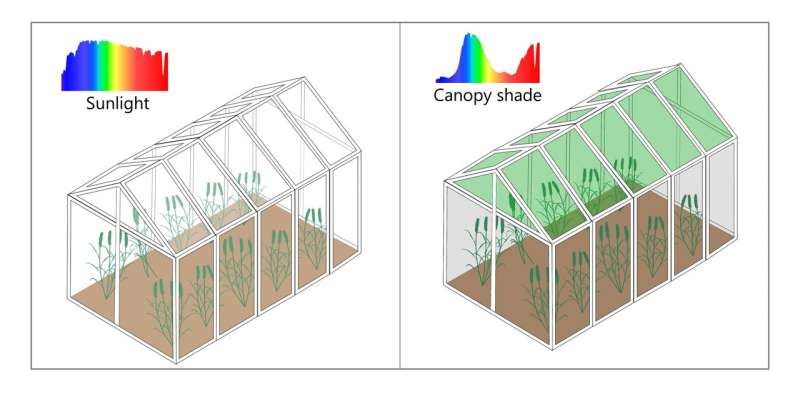This article has been reviewed according to Science X's editorial process and policies. Editors have highlighted the following attributes while ensuring the content's credibility:
fact-checked
peer-reviewed publication
proofread
Researchers provide genetic explanations for shade-induced biomass allocation in wheat

Recent studies have shown a strong correlation between responses to plant density and low light, indicating that the scarcity of light is often a limiting factor in high-density crop communities.
Practices such as tillage, fertilizing the soil, and regulating the water supply can reduce competition for water and nutrients, but they amplify competition for light. "These observations suggest that studying the genetic basis of plant responses to changes in the intensity and spectrum of light due to competition from neighboring plants will advance our understanding of adaptation to the crop environment," says Dr. Guy Golan, first author of a new study published in the journal New Phytologist
In their study, the research team applied a new approach that combines principles from plant ecology and quantitative genetics for dissecting light-dependent and size-dependent allocation and identifying genes that regulate allocation to the leaves, stems, spikes, and grains when plants are shaded by neighbors.
One stimulating example comes from the known 'Green Revolution' gene Reduced Height-B1, which has two gene forms. On the one hand, the wild version leads plants to put much of their resources into growing tall stems. When these plants are in the shade, they grow even taller to compete for more sunlight. On the other hand, plants with the 'Green Revolution' mutation allocate more resources to the spike, especially in shady conditions, making them more adaptable to low light.
However, allocation to the spike is also size-dependent. When the conditions are conducive for growth, the short, semi-dwarf plants allocate significantly more resources to the spike than the tall varieties. Under low resources, when the plants are small, this advantage significantly decreases. "This finding helps us understand the results from previous studies, which showed that these shorter plants don't always do better than taller ones during droughts when the plants are small," says Dr. Guy Golan.
"Our approach provides a basis for exploring the genetic determinants underlying investment strategies in the face of different resource constraints, and will be useful in predicting social behaviors of individuals in a crop community," says Prof. Dr. Thorsten Schnurbusch, head of IPK's research group "Plant Architecture."
More information: Guy Golan et al, Agroecological genetics of biomass allocation in wheat uncovers genotype interactions with canopy shade and plant size, New Phytologist (2024). DOI: 10.1111/nph.19576
Journal information: New Phytologist
Provided by Leibniz Institute of Plant Genetics and Crop Plant Research




















